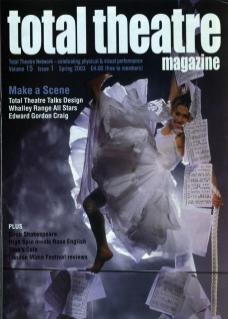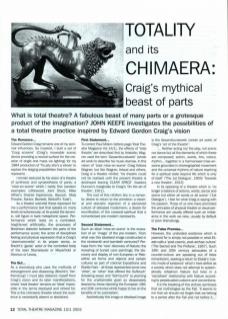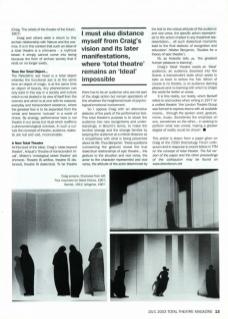The Romance...
Edward Gordon Craig remains one of my seminal influences. So inspired, I built a set of ‘Craig screens' (Craig's moveable scenic device providing a neutral surface for the creation of angle and mass via lighting) for my 1984 production of Tis pity she's a whore to explore the staging possibilities that his ideas represent.
I remain seduced by his vision of a theatre of synthesis and synaesthesia of parts; a 'mise-en-scene' which I rarely find (random examples: Littlewood, Joint Stock, Mike Alfred's Shared Experience, Bausch, Maly Theatre, Kantor, Beckett, Berkoff's East).
As a theatre scientist these represent for me a performance text that speaks on many levels simultaneously; at its purest the dynamic, still figure in bare metaphoric space. Performance which rests on a controlled, heightened artificiality, the processes of Brechtian dialectic between the parts of the performance score; the actor of disciplined feeling and physical expression that is Craig's ‘ubermarionette' in its proper sense, or Brecht's 'gestic' actor or the controlled body of the later Stanislavski or Meyerhold or Decroux or Lecoq.
The But...
As a dramaturg who uses the methods of estrangement and distancing (Brecht's 'Verfremdung’) I must also distance myself from Craig's vision and its later manifestations, where ‘total theatre' remains an 'Ideal', impossible in the terms deployed and strived for. This is the chimaeric theatre where the audience is necessarily absent or abolished.
First Statement...
To correct Paul Miskin (letters page Total Theatre Magazine Vol 14/1), the effects of ‘total theatre' are described first by Aristotle: Wagner used the term 'Gesamtkunstwerk' (whole art work) to describe his music-dramas. In this vision of ‘total mise-en-scene' Craig follows Wagner; but like Wagner, Artaud and others, Craig is a theatre nihilist: ‘his theatre could not be realised until the present theatre is destroyed leaving CLEAR SPACE’ (Isadora Duncan's marginalia to Craig's 'On the art of theatre', 1911).
The root of this nihilism lies in a romantic desire to return to the primitive: a visceral and atavistic rejection of a perceived culture of debased modernism; a desire for reunification of the corporeal-spiritual that a romanticised pre-modem represents.
Second Statement...
Such an ideal 'mise-en-scene' is the evocation of an 'imago' of the pre-modern. From what was this idealised image constructed in the nineteenth and twentieth centuries? Perhaps from: the 'new' discovery of Nature; the revealing of buried cave paintings; the discovery and display of non-European or Paleolithic artforms and objects and certain cultures as part of colonial Expositions and Worlds Fairs – all these represented some new 'other', an 'other' that offered the Aufbruch (breaking away) and 'Sehnsucht' (a yearning for the unattainable goal) so desperately desired by those rejecting the European 19th and 20th centuries whilst happy to live on the benefits of its colonialism.
Aesthetically this imago or idealised image is the Gesamtkunstwerk (whole art work) of Craig's 'art of the theatre':
... Neither acting nor the play, not scene nor dance but all the elements of which these are composed; action, words, line, colour, rhythm... together in a harmonised mise-en-scene grounded in choreographed movement and the universal rhythms of nature reaching for a spiritual state beyond life which is only of itself (‘The 1st Dialogue', 1905 / 'Towards a new theatre', 1913).
In its opposing of a theatre which is 'no longer a balance of actions, words, dance and scene but either all words or all scene' ('1st Dialogue’), I feel for what Craig is saying with his passion. Those of us who have promoted the principles of physical theatre or visual performance are usually offered such an imbalance in the work we view, usually by default or poor dramaturgy.
The False Premise...
However, the undivided existence which is yearned for is simply not possible in what Eliade calls a 'post-cosmic, post-archaic culture’ ('The Sacred and The Profane', 1957). Such 19th and 20th century advocates of a counter-culture are speaking out of false romanticism, seeking a return to Eliade's 'cosmic mode of existence' which I here define as a society which does not attempt to systematically refashion Nature but lives in a 'sacralised' relationship with Nature according to perpetuated customs and conventions.
It is the breaking of this archaic symbiosis that we mythologise as the Fall. ‘It seems to me that we should not forget that we belong to a period after the Fall and not before it...'
(Craig, ‘The artists of the theatre of the future', 1907)
Craig and others seek a return to this archaic relationship with Nature and the cosmos. It is in this context that such an ideal of a total theatre is a chimaera – a mythical beast: it simply cannot come into being because the form of archaic society that it rests on no longer exists.
Thus the Total Object...
The Paleolithic axe head is a total object whereby the functional axe is at the same time an object of magic, is at the same time an object of beauty. Any phenomenon can only exist in this way in a society and culture which is not divided in its view of itself from the cosmos and which is at one with its corporeal everyday and transcendent existence, where the greatest fear is to be separated from the whole and become 'outcast' in a world of chaos. By analogy, performance here is not theatre in our sense but ritual which reaffirms a phenomenological oneness. In such a culture the concepts of theatre, audience, dialectic are null and void, inconceivable.
A New Total Theatre
At this level of the Ideal, Craig's 'state beyond theatre'. Artaud's ‘theatre of transcendent ritual', Miskin's 'ontological street theatre' are chimeric. Theatre IS artifice, theatre IS distanced, theatre IS dialectical. To be theatre there has to be an audience who are not part of the stage action but remain spectators of this whatever the heightened level of psychological/emotional involvement.
So I oppose Craig with an alternative dialectic of the parts of the performance text. This total theatre's purpose is to shock the audience into new recognitions and understandings; in Brecht's terms, to make the familiar strange and the strange familiar by keeping the audience at a critical distance as it empathises with what is being presented about its life. Thus Benjamin: ‘these questions (concerning the gesture) reveal the true dialectical relationships of epic theatre... the gesture to the situation and vice versa, the actor to the character represented and vice versa, the attitude of the actor determined by the text to the critical attitude of the audience and vice versa, the specific action represented to the action implied in any theatrical representation... all such dialectical moments lead to the final dialectic of recognition and education.' (Walter Benjamin, ‘Studies for a theory of epic theatre')
Or, as Aristotle tells us, ‘the greatest human pleasure is learning’.
Craig's 'Ideal' theatre needs an 'Ideal’ audience; an audience dissolved into the Scene, a transcendent state which seeks to take us back to before the Fall. Which of course is no theatre, is no audience deriving pleasure and no learning with which to shape the world for better or worse.
It is this reality, our reality, which Berkoff refers to and evokes when writing in 1977 on a unified theatre: 'the London Theatre Group was formed to express drama with all available means... through the spoken word, gesture, mime, music. Sometimes the emphasis on one, sometimes on the other... in seeking to perform what was unreal, hoping a greater degree of reality would be shown.'
This article is drawn from a paper given on Craig at the CSSD Dramaturgy Forum colloquium and in response to recent letters in TTM on the concept of total theatre. The full version of the paper and the other proceedings of the colloquium may be found on www.dramforum.net


